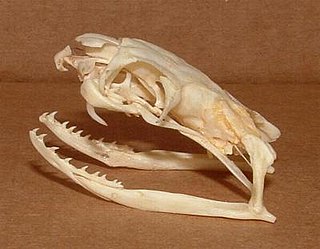A simile is a figure of speech that directly compares two things. Similes differ from metaphors by highlighting the similarities between two things using comparison words such as "like", "as", "so", or "than", while metaphors create an implicit comparison. This distinction is evident in the etymology of the words: simile derives from the Latin word similis, while metaphor derives from the Greek word metapherein. As in the case of metaphors, the thing that is being compared is called the tenor, and the thing it is being compared to is called the vehicle. Author and lexicographer Frank J. Wilstach compiled a dictionary of similes in 1916, with a second edition in 1924.

Snakes are elongated, limbless, carnivorous reptiles of the suborder Serpentes. Like all other squamates, snakes are ectothermic, amniote vertebrates covered in overlapping scales. Many species of snakes have skulls with several more joints than their lizard ancestors, enabling them to swallow prey much larger than their heads. To accommodate their narrow bodies, snakes' paired organs appear one in front of the other instead of side by side, and most have only one functional lung. Some species retain a pelvic girdle with a pair of vestigial claws on either side of the cloaca. Lizards have independently evolved elongate bodies without limbs or with greatly reduced limbs at least twenty-five times via convergent evolution, leading to many lineages of legless lizards. These resemble snakes, but several common groups of legless lizards have eyelids and external ears, which snakes lack, although this rule is not universal.

Cobra is the common name of various snakes, most of which belong to the genus Naja.

Colubridae is a family of snakes. With 249 genera, it is the largest snake family. The earliest species of the family date back to the Oligocene epoch. Colubrid snakes are found on every continent except Antarctica.

Garter snake is the common name for small to medium-sized snakes belonging to the genus Thamnophis in the family Colubridae. Native to North and Central America, species in the genus Thamnophis can be found in all of the lower 48 United States, and nearly all of the Canadian provinces south of the Northwest Territories and Nunavut—with the exception of Newfoundland and Labrador. They are found from the subarctic plains of west-central Canada east through Ontario and Quebec; from the Maritime Provinces and south to Florida, across the southern and central U.S. into the arid regions of the southwest and México, Guatemala and south to the neotropics and Costa Rica.
José Alberto de Oliveira Anchieta was a 19th-century Portuguese explorer and naturalist who, between 1866 and 1897, travelled extensively in Portuguese Angola, Africa, collecting animals and plants. His specimens from Angola and Mozambique were sent out to Portugal, where they were later examined by several zoologists and botanists, chiefly among them J.V. Barboza du Bocage.

The inland taipan, also commonly known as the western taipan, small-scaled snake, or fierce snake, is a species of extremely venomous snake in the family Elapidae. The species is endemic to semiarid regions of central east Australia. Aboriginal Australians living in those regions named the snake dandarabilla. It was formally described by Frederick McCoy in 1879 and then by William John Macleay in 1882, but for the next 90 years, it was a mystery to the scientific community; no further specimens were found, and virtually nothing was added to the knowledge of this species until its rediscovery in 1972.

Venomous snakes are species of the suborder Serpentes that are capable of producing venom, which they use for killing prey, for defense, and to assist with digestion of their prey. The venom is typically delivered by injection using hollow or grooved fangs, although some venomous snakes lack well-developed fangs. Common venomous snakes include the families Elapidae, Viperidae, Atractaspididae, and some of the Colubridae. The toxicity of venom is mainly indicated by murine LD50, while multiple factors are considered to judge the potential danger to humans. Other important factors for risk assessment include the likelihood that a snake will bite, the quantity of venom delivered with the bite, the efficiency of the delivery mechanism, and the location of a bite on the body of the victim. Snake venom may have both neurotoxic and hemotoxic properties. There are about 600 venomous snake species in the world.

Blatačko Lake is a natural lake 21 kilometers to the north-east of Konjic, in Konjic municipality, Bosnia and Herzegovina. The lake is a central feature of the natural & cultural-historical ensemble - cultural landscape - designated as National Monument of Bosnia and Herzegovina.
Trimetopon is a genus of snakes in the family Colubridae. The genus is native to Costa Rica and Panama. Species in the genus Trimetopon are known commonly as tropical ground snakes.
Barbour's tropical ground snake, also known commonly as Barbour's pygmy snake, is a species of snake in the family Colubridae. The species is endemic to Panama.

Dipsadinae is a large subfamily of colubroid snakes, sometimes referred to as a family (Dipsadidae). They are found in most of the Americas, including the West Indies, and are most diverse in South America. There are more than 700 species.

Joseph Richard Slevin was an American herpetologist and the second curator of herpetology at the California Academy of Sciences, with which he was affiliated for over 50 years. He collected reptile and amphibian specimens from around the world, notably in the Galápagos Islands in a 17-month expedition, and was largely responsible for re-growing the academy's herpetological collection following its destruction in the 1906 San Francisco earthquake. He wrote or co-wrote nearly 60 scientific papers, and is commemorated in the scientific names of over a dozen species or subspecies of animals and plants.
Trimetopon gracile, Günther's tropical ground snake, is a species of snake in the family, Colubridae. It is found in Costa Rica.
Trimetopon pliolepis , Cope's tropical ground snake, is a species of snake in the family, Colubridae. It is found in Nicaragua, Costa Rica, and Panama.
Trimetopon slevini, Slevin's tropical ground snake, is a species of snake in the family, Colubridae. It is found in Costa Rica and Panama.
Trimetopon viquezi, Viquez's tropical ground snake, is a species of snake in the family, Colubridae. It is found in Costa Rica.









